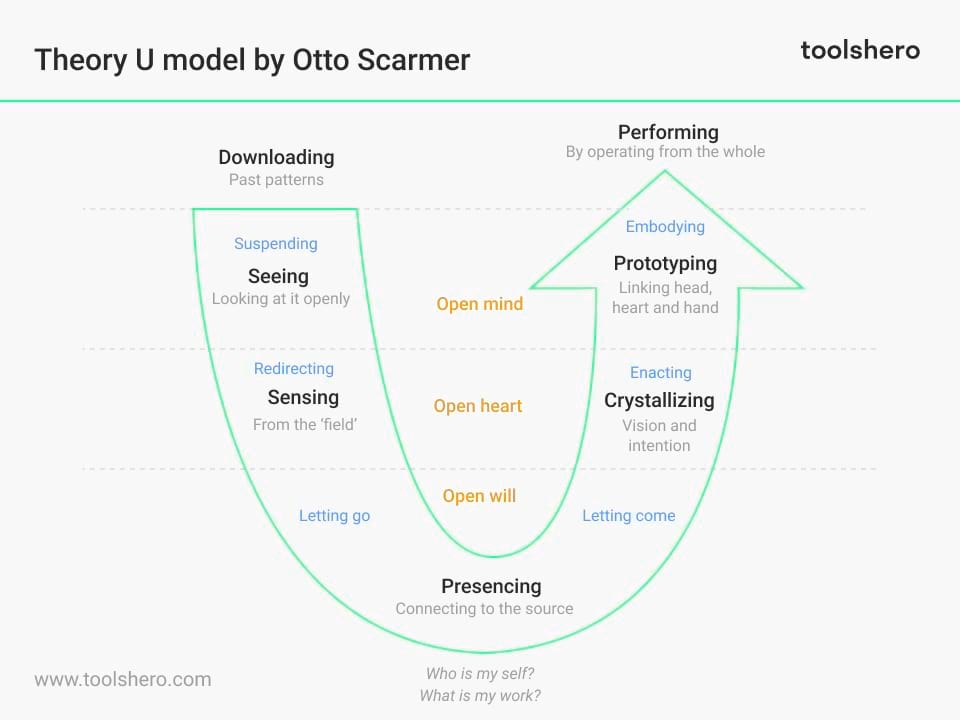Theory U by Otto Scharmer explained

Theory U: this article explains Theory U, developed by Otto Scharmer in a practical way. After reading you will understand the basics of this leadership tool. Highlights include: an introduction to this theory and dissociation, an explanation of presencing, an example of the U model, the role of cooperation and an holistic approach. Enjoy reading!
Introduction
As part of society, organizations are hardly or not at all able to respond to changes that are taking place in the world.
Organizations are stuck in their institutional thinking with respect to their solutions concerning global issues and problems like famine, poverty and pollution.
Theory U: Dissociation
Otto Scharmer was intrigued by this phenomenon when he was working as a senior lecturer at the Massachusetts Institute of Technology (MIT) Sloan School of Management.
Scharmer therefore decided to write his ground breaking book Theory U: Leading from the Future as It Emerges (2009). This was a further development of the book Presence (2006) that he wrote with Peter Senge and co-authors Joseph Jaworski and Betty Sue Flowers.
With his Theory U (or u theory), Scharmer tries to provide points of reference so that people dissociate themselves from their habitual way of thinking.
He explains in which way an individual can make their own contribution to possible solutions that are in tune with what society actually needs. Theory U is about personal leadership and a different way of thinking.
What is Presencing?
According to Otto Scharmer there are two ways of learning: from the past and from the future.
The latter takes place for instance by focusing on future possibilities without being afraid. Scharmer refers to this as ‘presencing’; an amalgamation of the words ‘presence’ and ‘sensing’ (feeling).
In short, ‘presencing’ means to connect to the deepest source of your self in the present moment and allow your inner knowing to emerge.
In chapter 11 of his book Theory U, Scharmer describes presencing as follows: “Presencing, the blending of sensing and presence, means to connect from the Source of the highest future possibility and to bring it into the now.
Presencing happens when our perception begins to happen from the source of our emerging future. The boundaries between three types of presence collapse: the presence of the past (current field), the presence of the future (the emerging field of the future), and the presence of one’s authentic Self.
When this co-presence, or merging of the three types of presence, begins to resonate, we experience a profound shift, a change of the place from which we operate.”
What is the Theory U model?
The Theory U, co-developed by Otto Scharmer, is represented as a U shape that moves from the left-hand side of the U to the right-hand side of the U.
An individual will have to open their mind to new ideas first and they must not be obstructed by thoughts and emotions.

Figure 1 – Theory U Model (Scharmer, 2009)
It is not until these obstructions are lifted that the will arises to change effectively. From this point onwards, the theory on the right-hand side slowly works in an upward direction towards reintegration and acceptance of new and innovative ideas. From this point onwards new ideas can be used in practice.
Presencing is therefore a process of letting go of the old and letting come of the new. In the ‘crystallizing’ phase of the right-hand side you envision a potential future and you crystalize the insights and ideas that came up during presencing. From the ‘blind spot’ something news emerges out of nowhere.
In the ‘prototyping’ phase you link head, heart and hand by embodying and trying out the first ideas.
In the final ‘performing’ phase you execute the plans by operating from and for the greater whole.
Theory U: Cooperation
Theory U is about collectively creating results. By joining forces and working well together at all levels in organizations people are capable of relinquishing established ideas, practices and even identities.
According to Scharmer, this results in new ideas and solutions that can make a contribution to the environment and to the future.
According to him the real work of leaders and change-makers lies in cultivating the so-called social field, by which he means the structure of the relationship among individuals, groups, organizations and systems that gives rise to collective behaviors and outcomes.
In 2006 Scharmer co-founded the Presencing Institute ‘to develop the theory and practice of systems transformation and to support individuals, organizations and multi-sector groups to bring about change in their own contexts.’
Listening
A prerequisite for establishing good ‘presencing’ is the way in which we are able the listen. Scharmer has divided listening into four levels:
1. Downloading
When transferring information that is already largely familiar, people only listen to reconfirm what they already know.
2. Factual listening
People only listen and pay attention when the information is different from what they know. This new information is added to the information that is already known.
3. Empathic listening
By empathizing and seeing through someone else’s eyes, people are able to understand and respect the other person.
4. Generative listening
People listen to create without their personalities getting in the way of results. By connecting their own intuition with the environment, they tap into pure thoughts and ideas.
Theory U is practice oriented
Theory U provides a framework and method to accomplish awareness-based change. In practice managers use this as an important tool to encourage employees to deal with certain situations differently and to have an open mind with respect to new and different thoughts.
A number of specific characteristics of Theory U that are linked to practice:
- Both executives and employees are better able to focus on the successes they have achieved.
- Innovation becomes a common cause and forms an integral part of the (departmental) policy.
- Both individual developments and organizational developments are considered valuable and this creates a natural connection and interaction between people and the organization.
- Social technologies are deployed and play an important part in conflict resolution and this will result in more respect between the different parties.
Holistic approach of Theory U
Theory U has a holistic approach that can be traced back to Buddhism, Taoism and Sufism. It is important to go beyond the personality and to start looking for the ‘true self’.
Theory U enables people throughout organizations to let go of the prevailing approach that is based on the past and to focus more on the future. This enables them to take a critical look at themselves and as a result they will then embrace their own intuitions and those of other people.
Now It’s Your Turn
What do you think? Is Theory U applicable in today’s modern economy? Do you recognize the practical explanation or do you have more suggestions? What are your success factors for using the Theory U?
Share your experience and knowledge in the comments box below.
More information
- Senge, P. M., Scharmer, C. O., Jaworski, J., Flowers, B.S. (2008). Presence: Human Purpose and the Field of the Future. Crown Business.
- Scharmer, C.O. (2009). Theory U: Learning from the future as it emerges. Berrett-Koehler Publishers.
- Scharmer, C.O. & Kaufer, K. (2013). Leading from the Emerging Future: From Ego-System to Eco-System Economies. Berrett-Koehler Publishers.
- Scharmer, C.O. (2007), Addressing The Blind Spot of Our Time. An executive summary of the new book by Otto Scharmer Theory U: Leading from the Future as It Emerges.
How to cite this article:
Mulder, P. (2012). Theory U (Scharmer) Retrieved [insert date] from Toolshero: https://www.toolshero.com/leadership/theory-u-scharmer/
Original publication date: 09/17/2012 | Last update: 12/27/2023
Add a link to this page on your website:
<a href=”https://www.toolshero.com/leadership/theory-u-scharmer/”> Toolshero: Theory U (Scharmer)</a>












